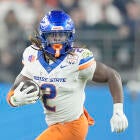During my training camp visit with the Green Bay Packers last summer, Packers coach Mike McCarthy told me Aaron Rodgers had mastered the quarterback position.
It came easy to him, and he made it all look so easy.
That certainly isn’t the case right now. Rodgers, who I still think is the best quarterback in the league and on his way to being one of the greatest of all-time, is going through a rough patch -- by his standards. He still is on pace to throw for nearly 4,500 yards and he has 21 touchdown passes to go with three picks, but in the past three games, all losses, Rodgers has looked off.
It’s not all him. In fact a lot of it isn’t, but the problems surrounding him are clearly taking a toll on Rodgers as a quarterback. The quick-trigger decisions aren’t as quick. The ear-hole throws into tight windows aren’t as prevalent. The timing and rhythm seem off. And he's dealing with a shoulder issue -- coach Mike McCarthy said that the quarterback "was a little banged up" on Wednesday.
Rodgers has become jumpy in the pocket. There are times when he passes on open receivers, sometimes locking in on a pre-determined read, even if it’s not open. His ability to escape pressure in the pocket, keep his head up, and slide or move to make a throw, has been his calling card.
Now it’s not as much. Teams are doing a better job of keeping him on the spot or close to it and his receivers aren’t winning. That creates a situation where he's holding the football, which leads to sacks and other issues.
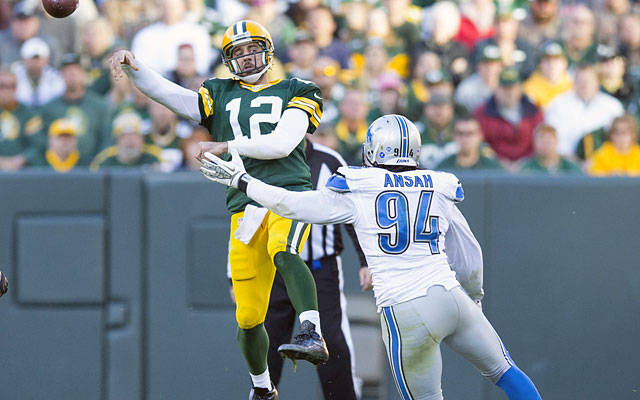
Green Bay’s offensive numbers are stunning for a team that we’ve come to expect to be an offensive power. The Packers are 21st in total offense, 11th in scoring, 22nd in passing yards per game, 17th in passing yards per play, and tied for 18th in third-down efficiency.
Think about the last one: There are 17 teams in the league better than the Packers on third down, including the Cleveland Browns, New York Jets and Tampa Bay Buccaneers.
It’s not like the Packers are running well, either. Eddie Lacy has been one of the biggest disappointments so far this season, and he’s on the bench. Green Bay is 16th in rushing and 11th in yards per rush.
With nobody threatening down the field in the passing game, there are a lot of instances where the defenders outnumber the blockers, which makes it tough to run.
Add it all up, and it’s been a frustrating start for an offense that isn’t used to struggling. That’s struggling, by the way, by Packers standards with Rodgers. Not like some offense that is inept.
McCarthy has been the team’s play-caller since taking over as coach in 2007. He stepped back from that this year to help with other areas of the team, giving those duties to assistant head coach Tom Clements. Maybe it’s time for McCarthy to take over calling plays again. He’s always been one of the best, and something needs to be done.
McCarthy said this week it won’t change, and Rodgers does handle a lot of the offense at the line of scrimmage, but I still think it needs to be livened up, and McCarthy would do that.
Scheme is an issue
The Packers are big on isolation routes, with little in terms of bunch formations or pick plays. They spread out the receivers and allow Rodgers to go through his progressions. That’s all well and good when receivers win, but that isn’t happening much anymore.
When Jordy Nelson went down with a knee injury and was lost for the season, few expected it to impact the offense the way it has. With Nelson out, Randall Cobb has become the No. 1 receiver, which means he gets more attention. Cobb has had a tough time dealing with the double at times. The other receivers don’t win much against man coverage.
As one NFL corner said to me this week, “They don’t have a deep threat so everybody is just getting up and playing man.”
In simple terms: Nobody scares.
Cobb is more of an intermediate route runner and James Jones and Davante Adams don’t threaten much vertically. That has led to Rodgers holding the ball as he makes his progressions. It’s also led him to feel pressure when it isn’t there as the clock goes off in his head.
Here’s a look at a play from last week’s game against the Lions that shows the receivers aren’t winning.
The Lions are matched up in man coverage against the look the Packers use most of the time, which is the “Posse” or “11” personnel, which is one back, one tight end and three receivers.
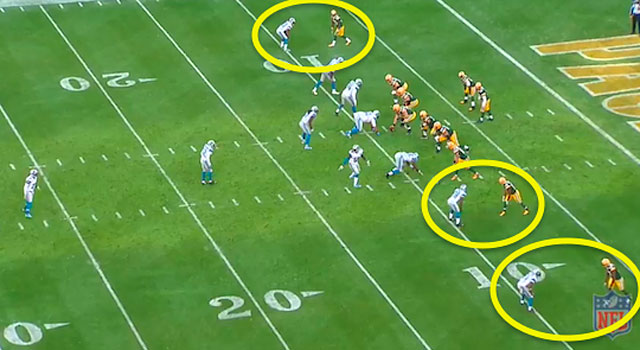
What the Lions do is use safety Isa Abdul-Quddus in the middle of the field to take away the inside route for Cobb. In other words, he’s doubled.
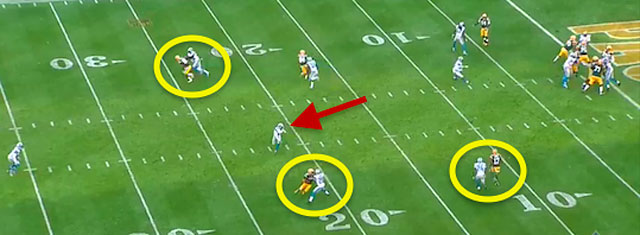
That allowed corner Quandre Diggs to play with outside leverage, which makes it a lot easier to cover him in man coverage.

Rodgers tried to a fit a pass into Cobb, but he was clearly covered and had no chance of completing the pass.
The Packers might want change things up, try and use more pick plays out of bunch formations or two-by-two looks to free up receivers. Early in the season, they had success using plays where the receivers would block for another pass catcher before the ball was caught.
The NFL tightened up on that with penalty flags. With that being called closer, it has cut down on those plays being called by the Packers, although they still try them once in a while.
The New England Patriots don’t have great receivers, but they do a great job of scheming open players with rubs and pick routes. I bring that up because Green Bay needs to borrow some pages from the Patriots’ playbook. I know those aren’t a staple in the West Coast offense, but the Packers need to amend that and use more.
They are stale.
When they have used those plays, they’ve had some success. Here’s a look at a play from last week’s game where Jared Abbrrederis got open thanks to a pick by Adams. Take a look:
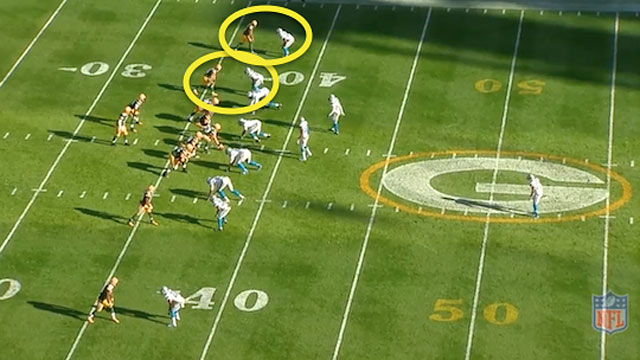
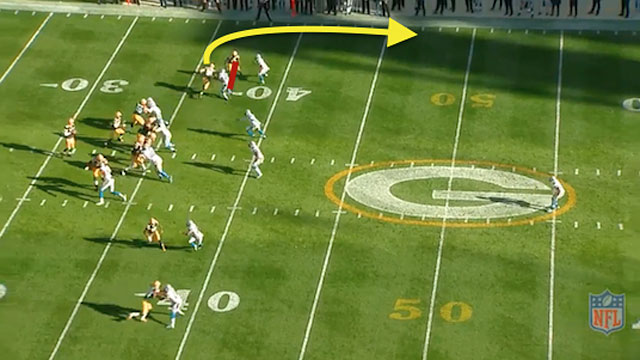
It was Adams’ pick on Diggs that made it possible for Abbrederis to get open outside.

The Packers don’t do enough of this.
They used the same type of concept against the Rams in Week 6 to get their first touchdown on a 31-yard catch and run by Ty Montgomery.
On the play, Montgomery motioned from wide outside to a spot next to tight end Richard Rodgers, who cleared out the area with his route, allowing Montgomery to come inside of him for an easy catch for a touchdown.

I think we could be seeing more of this in the coming weeks as Rodgers hinted there could be changes coming. That would be wise.
With no respect outside for the passing game, it makes it tougher to run the football. Teams can bring an extra man down, making it hard to block the fronts. In this case it isn’t an eighth man because the Packers play so many three-receiver, one-tight end sets. But it’s the seventh who causes problems.
Here’s a look at a play from the Denver game. The Packers had their usual “11” personnel in the game, and the Broncos matched up in man coverage. That left zero coverage in the middle, which basically dares a team to throw there. Instead, the Packers ran into this look.
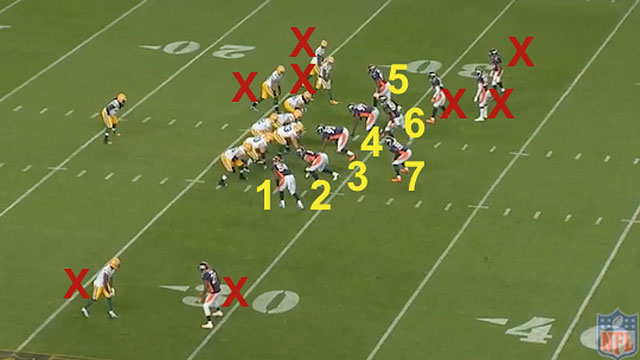
The Packers had two receivers and Richard Rodgers to the left in a bunch with Adams split out wide to the right with Aqib Talib in man coverage. The X's on the pictures show the defensive backs locked in man coverage.
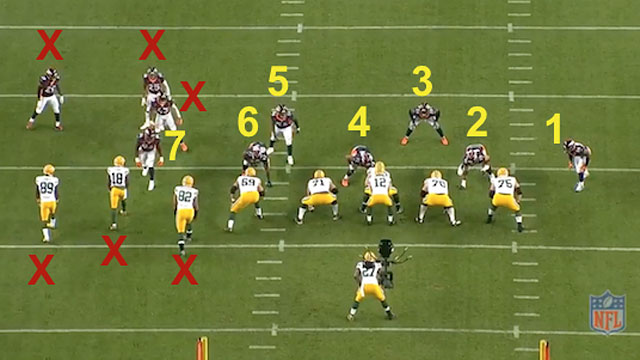
That leaves seven players to be blocked by five. With Broncos safety T.J. Ward in man coverage on Richard Rodgers, he is like the eighth man when Rodgers goes to block him. The numbers don’t work, which is why Lacy gained a yard.

This is a direct result of the passing game not threatening down the field.
Rodgers also isn’t getting great play from his tackles. That has been a season-long problem. Left tackle David Bakhtiari has regressed and right tackle Bryan Bulaga, who missed four games with injuries, has also struggled. Replacement Don Barclay was awful in place of Bulaga.
“I don’t know if he trusts his O-line too much,” the corner said.
The long-developing isolation routes, coupled with the poor play up front in pass protection, has led to a jumpier Rodgers. For some reason, he is also hesitant at times to pull the trigger.
Against the Lions, he had Cobb wide open in the middle on one play and pulled the ball down instead of making a throw. To see how different that is for him, I put on the tape from the Cowboys playoff game last January.
There is a play in that game where Rodgers fires a bullet to Adams in a small, small window that turned into a 46-yard touchdown pass. That was vintage Rodgers.
The Cowboys were in a two-deep look with man under and Rodgers calmly stepped up in the pocket, taking the Rodgers bounce forward that we’ve come to see a lot, and then fired a shot with his quick release that just got past the hand of corner Sterling Moore.
In an interview published in GQ magazine this week, President Obama said he sometimes felt like Aaron Rodgers in the pocket.
"In the sense of you can't be distracted by what's around you, you've got to be looking downfield," he said.
That hasn’t always been the case for this version of Rodgers. That doesn’t mean it can’t change. In fact, I expect it will, starting this week at Minnesota.
This offense, which featured all 11 starters back before Nelson went down, is too good to be playing at this level. They just need to get a little more creative.
Sometimes, change is good.
They don’t have good enough receivers outside to play the same, tired way. I think McCarthy and Rodgers are smart enough to realize this and we will start to notice a difference.
One more thing: Play faster. That was something that Rodgers seemed to feed off of, but they don’t do it enough anymore. Some Packers players mentioned that as an issue this week.
Like McCarthy said last summer, Rodgers has mastered the quarterback position. But what the Packers are learning that not even that mastery can overcome some of this unit’s limitations.
More observations from watching tape this week
The weekly J.J. Watt review: In my weekly look at Texans defensive end J.J. Watt, who is the best defensive player in the league, he had a solid game against the Bengals on Monday night, even if it wasn’t dynamic by his standards. Watt had one sack and two quarterback hits, but he got a lot of attention from the Bengals. Sometimes, there were three guys focused on trying to block him.
On his sack, he bull-rushed Eric Winston, the right tackle, and then shed him to drop Andy Dalton. He spent most of the night lined up on Winston, who was playing for the injured Andre Smith.
When Watt went to the opposite side and was matched with Andrew Whitworth, he didn’t have the same success. Whitworth did a nice job on him in the handful of plays they were matched.
Watt also lined up some standing up over the center, which can create a lot of problems. He got push inside, but it also helped the guys looping outside of him.
One play really stood out to me, and it didn’t show up in the stat sheet. On a run that went completely away from him, Watt nearly chased down Jeremy Hill on the other side of the field. His speed on that play was unreal for a man his size. Take a look at it if you get the chance.
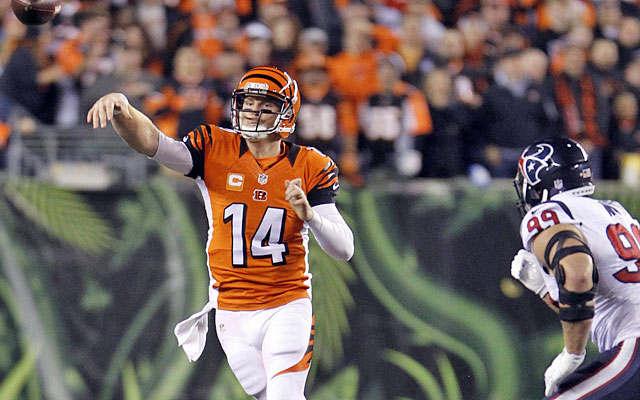
While watching Watt, some other things stood out about the Houston defense. Among them:
- Whitney Mercilus is starting to play like the team expected when it drafted him in the first round in 2012. He is getting pressure, but he’s also playing the run well. He had a stop on a reverse for an 8-yard loss, but he also made a lot of other nice plays. His ability to get pressure opposite Watt is important for this team. If he can continue like that when Jadeveon Clowney returns, that pass rush could be really good.
- Rookie inside linebacker Bernardrick McKinney is starting to play much better. He is a big, physical player and he showed up in the run game here. He also made a nice play on a screen pass for a 3-yard loss.
- The secondary played a lot of zone that took away the Bengals' deep balls. Dalton had chances to dump it down all night long, but he chose not to do so in a lot of situations. The Texans also did some good things with their linebackers. On one play, Brian Cushing was lined up inside, then at the snap made a fast move to the outside to help double A.J. Green.
- Rookie corner Kevin Johnson is going to be a heck of a player. He is fluid in coverage. With Kareem Jackson -- when he gets back from injury -- and Jonathan Joseph, the Texans have good corners.
Let's tap the brakes on the Watkins dominating Revis talk: Based on one amazing move, which led to a short catch and GIF sent out by many (see below), there was this idea that Bills receiver Sammy Watkins torched the Jets' Darrelle Revis last week.
Watkins v. Revis pic.twitter.com/3FleWxkdGW
— Bre (@bre_88) November 13, 2015
That’s simply not close to being true.
Watkins had three catches for 14 yards. Three?
But the Watkins backers insist that he was open a bunch, killing Revis with his feet and his speed.
I went back and watched the tape, and there were a handful of plays where Watkins beat Revis. But the reality is that Revis won a lot more than he lost. He carried Watkins a bunch on deep routes, running stride for stride with him.
Watkins got him on the first play of the game, but the ball was overthrown. But Revis was in a zone scheme that wasn’t man coverage. Still, he had Watkins as his responsibility.
Anybody who thinks three catches for 14 yards is a torching is nuts. Watkins had a big first-down catch against Revis to help seal the game for the Bills, but that’s the only significant play of note.
The winner: Revis.
Watkins did impress with his footwork, and coupled with his speed, he can be special. He just needs to stay on the field and continue to get better.
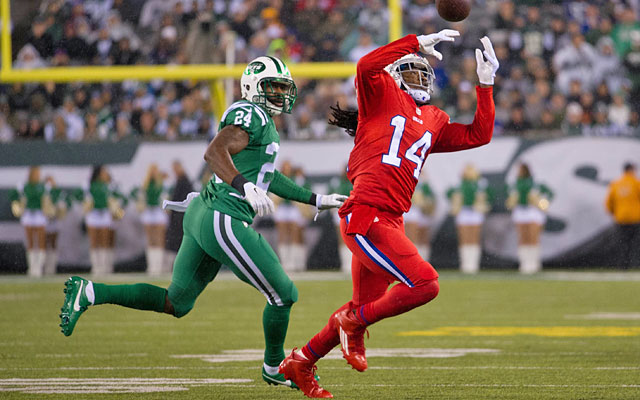
![[object Object] Logo](https://sportshub.cbsistatic.com/i/2020/04/22/e9ceb731-8b3f-4c60-98fe-090ab66a2997/screen-shot-2020-04-22-at-11-04-56-am.png)









